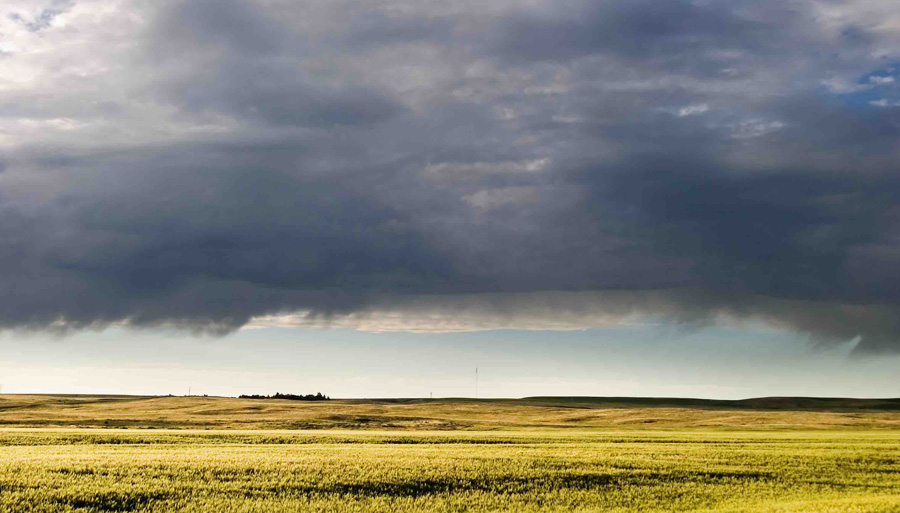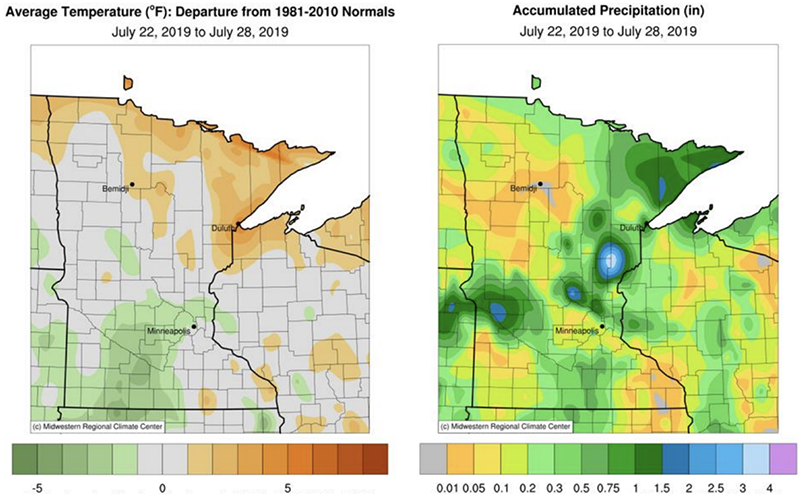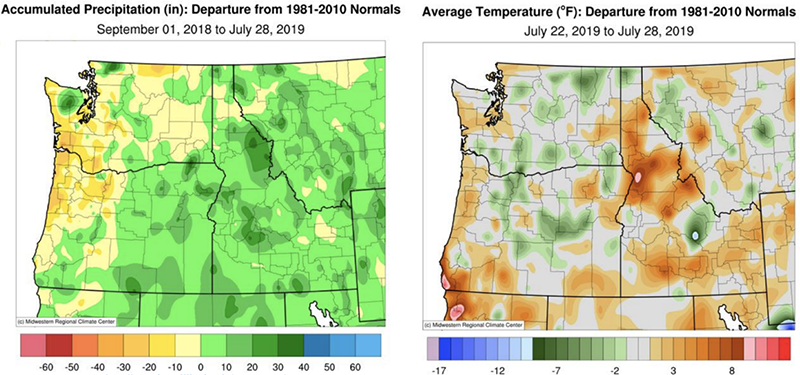August 2, 2019
For the week ending July 28th, good weather conditions prevailed across the major pulse growing regions.


Good weather conditions are allowing pulse crops to make up for the time lost due to rain delays at planting. In the Pacific Northwest, growers made good progress on the dry pea harvest.
Michigan is an important black bean growing state. Last week, 6.1 days were suitable for fieldwork. Conditions were warm and dry throughout the state, and growers expressed concern that the heat could dry out the soil. These conditions are in stark contrast to those that prevailed during the planting season, when wet conditions delayed seeding. Dry bean crop emergence was 90% with 18% of the plants blooming (behind the average of 51%). The crop rated 4% very poor, 15% poor, 24% fair, 39% good and 18% excellent.
Minnesota is a key kidney bean growing state. Last week, 5.1 days were suitable for fieldwork and there were some light rains. Topsoil moisture rated 71% adequate and 24% surplus. Subsoil moisture rated 70% adequate and 25% surplus. The dry bean crop was a few days behind because of late planting, with 71% of the plants blooming and 33% setting pods. The bean crop rated 5% very poor to poor, 30% fair, 57% good and 8% excellent.

Montana is a major producer of pulse crops. Warm and dry conditions prevailed last week, with 6.8 days suitable for fieldwork. Top- and subsoil moisture rated 74% and 71% adequate to surplus. In terms of crop progress, 52% of the dry bean crop (including chickpeas) was blooming, as was 95% of the lentil crop. The lentil crop rated 4% poor, 30% fair, 54% good and 12% excellent. The dry pea crop rated 7% very poor to poor, 22% fair, 59% good and 12% excellent.
North Dakota is the country’s top dry bean producing state. Last week, 6.6 days were suitable for fieldwork. Top- and subsoil moisture levels rated 75% and 77% adequate to surplus. The dry pea crop rated 5% poor, 21% fair, 68% good and 6% excellent, with 95% of the plants blooming and 33% dropping leaves. The dry bean crop rated 1% poor, 20% fair, 69% good and 13% excellent, with 81% of the plants blooming, which is at about the average pace, and 43% setting pods.
The Pacific Northwest is an important pulse producing region. Lately, the region has received favorable weather. Last week, there were 6.9 days suitable for fieldwork in Idaho and Oregon, and 6.7 in Washington. The dry pea crop is being harvested across the region, with harvest progress at 3% in Idaho, 61% in Oregon and 45% in Washington. In Idaho, the dry pea crop rated 33% fair, 59% good and 8% excellent. In Oregon, it rated 4% very poor, 16% poor, 21% fair, 33% good and 26% excellent. In Washington, it rated 2% poor, 13% fair, 74% good and 11% excellent. Turning to the dry bean crop, in Idaho it rated 32% fair, 63% good and 5% excellent. In Oregon, it rated 7% very poor to poor, 28% fair, 53% good and 12% excellent. In Washington, it rated 7% poor, 17% fair, 68% good and 8% excellent.

Disclaimer: The opinions or views expressed in this publication are those of the authors or quoted persons. They do not purport to reflect the opinions or views of the Global Pulse Confederation or its members.